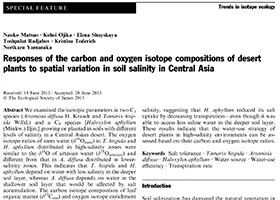Responses of the carbon and oxygen isotope compositions of desert plants to spatial variation in soil salinity in Central Asia.
Authors
Matsuo, N, Ojika, K, Shuyskaya, E, Radjabov, T, Toderich, K, Yamanaka, N
Year
2013
Publication Source
Ecological Research. Trends in Isotope Ecology
Publication type
Scientific Paper
ISBN
11284-013-1068-3
Volume/Chapter/Issue
28
Page Number
717-723
